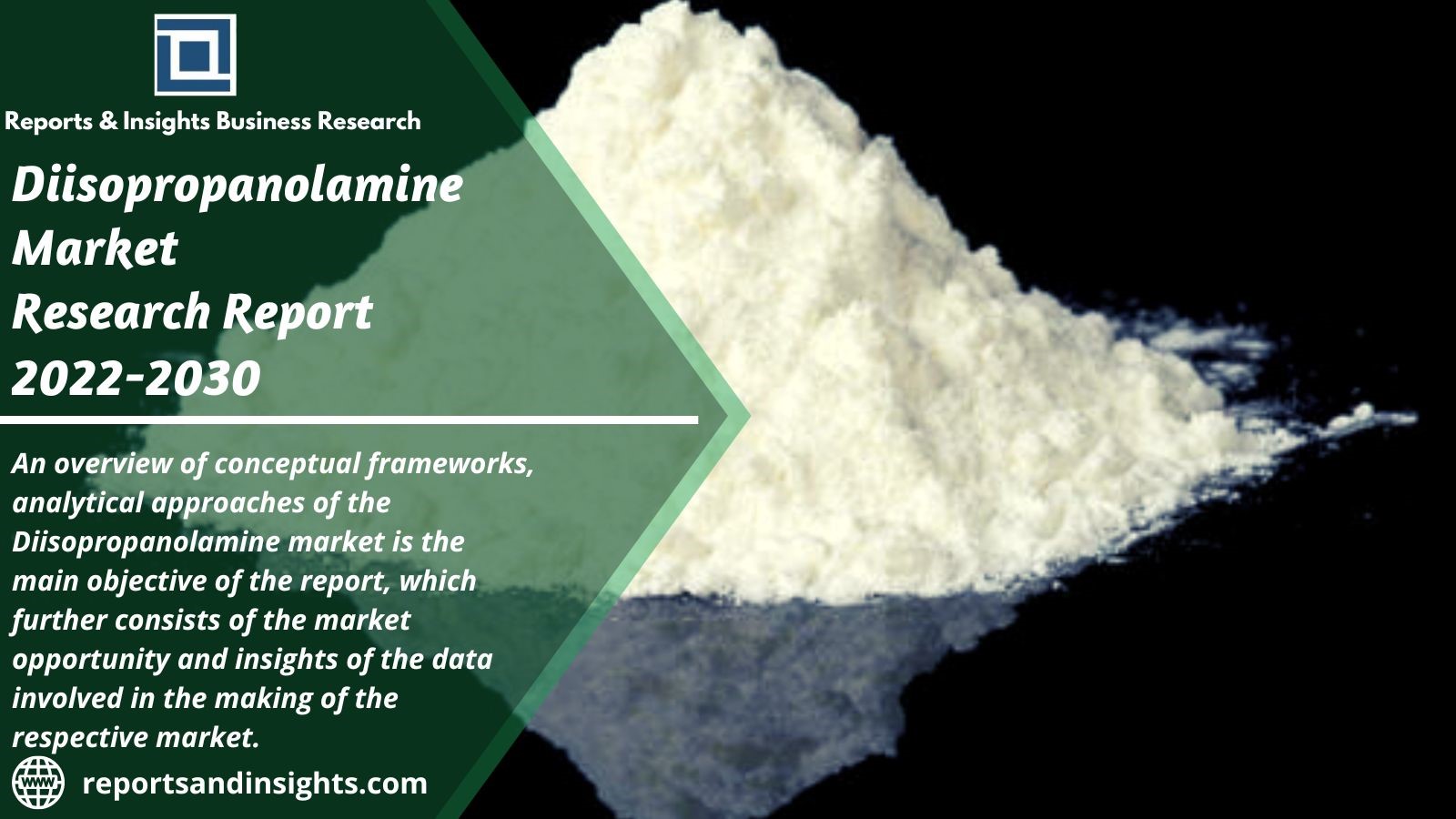Business
Diisopropanolamine Market Size, Research Analysis with Trends, Regional Analysis, Share and Forecast by 2030|

The global “Diisopropanolamine Market: Opportunity Analysis and Future Assessment 2022-2030” issued by Reports and Insights provides authentic and first-hand data, qualitative and quantitative analysis by industry analysts, and inputs from industry experts and stakeholders across the entire chain. The research examines current market trends, macroeconomic factors, regional analysis in-depth, as well as market attractiveness by segment. The market research provides SWOT analysis of competitors comprising extraneous environment assessment and PEST study. In addition, the market analysis offers business approaches for handling with COVID-19 impact on the market.
Diisopropanolamine Market, By Grade (Commercial Grade, Low Freeze Grade (DIPA Low Freeze Grade 90, DIPA Low Freeze Grade 85)), By Application (Personal Care & Cosmetics, Metal Working Fluids, Pest Control Chemicals, Food, Feed, Dairy and Beverage, Multipurpose Cleaners, Manufacturing Basic Chemicals, Protective Coatings, Others) and By Region (North America, Europe, Asia Pacific, Latin America, Middle East, & Africa) is expected to grow at a significant CAGR for the period between 2022 and 2030.
Request a Sample Copy of Diisopropanolamine Market Report
Diisopropanolamine (DIPA) can be classed as an amino alcohol that is a part of the group of alcohol amines. It can be perceived as a pallid and dull colored liquid or a whitish to yellow crystalline solid at room temperature, with the odor of ammonia. It is dissoluble in water.
Diisopropanolamine is a multipurpose chemical, which holds several roles across several applications among which one is of an emulsifying agent for textiles, polishes, insecticides, leathers, paints, and oils. It carries the potential to act as a buffer (stabilize pH), neutralize pH, or add basicity (alkalinity) to a solution.
Diisopropanolamine is a multifaceted chemical utilized in a range of cosmetics, personal care and industrial products. Moreover, diisopropanolamine is extensively utilized industrially for eradicating hydrogen sulfide and carbon dioxide from natural gas and refinery process streams. In addition, it serves as an emulsifying agent and also finds utility as a crosslinking impetus in the development of polyurethanes.
Added to that, it is used as an element of surfactants, insecticide, corrosion inhibitors, rubber chemicals and pigment dispersants. Attributing to such extensive scale of application across various industries, the global diisopropanolamine market is projected to rise substantially in the following years.
Furthermore, the comprehensive use of pest control chemicals in the agrochemical industry in the past few years has made a significant boost in the growth of the global diisopropanolamine market.
In terms of geography, the diisopropanolamine market can be divided into six regions – North America, Latin America, Europe, Asia Pacific, Middle-East, and Africa. The Asia Pacific region is projected to hold the major share of the global diisopropanolamine market due to the swift spread in the agrochemical industry in Japan, China, India, South Korea and Taiwan. Further, North America is estimated to follow after Asia Pacific considering the increasing demand of diisopropanolamine in pharmaceutical, agriculture, and plastic industries.
Notably, diisopropanolamine holds an essential role as an intermediate chemical in the manufacture of pest control chemicals such as insecticides, herbicides, fungicides, sprout inhibitors, biocides, and others. Be that as it may, the noxinousness of diisopropanolamine and regulations levied by the European Chemicals Agency (ECHA) are estimated to slow down the growth of the global diisopropanolamine market.
Reports and Insights Study identifies some of the key participating players in the diisopropanolamine market globally are Dow Chemical Company, BASF SE, LANXESS, Hongbaoli Group, ANGUS Chemical Company, among others.
Factors that are benchmarked while estimating the market
Various factors that are benchmarked while estimating the market growth includes (but not restricted to):
New product developments and launches
Global Chemical Industry Outlook
Top Companies Historical Growth Rate
Pricing Impact
Impact of Regulations
Advantages of Diisopropanolamine
-

 Blockchain Technology4 days ago
Blockchain Technology4 days agoBlockchain Beyond Cryptocurrency: 5 Game-Changing Applications You Should Know
-

 Business7 days ago
Business7 days agoDow Jones Drops Over 100 Points Amid Trade Talk Uncertainty
-

 Business6 days ago
Business6 days agoStock Futures Soar as US-China Trade Talks Yield Positive Results
-

 Business7 days ago
Business7 days agoU.S.-China Tariff Negotiations Resume Amid Economic Uncertainty
-

 Fitness & Wellness4 days ago
Fitness & Wellness4 days agoAre Smartwatches Worth It? The Best Wearable Tech of 2025
-

 Government6 days ago
Government6 days agoU.S. Government Intensifies Scrutiny of Social Security Notices Amid Funding Concerns
-

 Child Welfare6 days ago
Child Welfare6 days agoTrump’s Controversial Refugee Policy: Afrikaners Welcomed Amid Global Ban
-

 Politics5 days ago
Politics5 days agoTrump’s Administration Races Against Time to Prevent Government Shutdown














